|
||||||||||
|
|
||||||||||
|
||||||||||
|
|
||||||||||
The Space Shuttle abort modes can be categorized into three basic types. A Pad Abort occurs while the vehicle is still on the launch pad and prevents launch. Intact Aborts occur after launch and allow the Orbiter to return to a primary or emergency landing site for a safe recovery of the vehicle and crew. These abort modes are generally planned out ahead of time, have a high degree of automation that requires very little crew effort to implement, are included in routine training prior to flight, and have a high probability of success. At the other extreme are Contingency Aborts that are difficult to anticipate because they depend largely on the unique circumstances of the Shuttle failure condition. These aborts are intended to provide a means of saving the crew under more severe failures that prohibit an intact abort, and ditching of the Orbiter is a likely outcome. Contingency Aborts require far more manual effort on the part of the crew and are considered less likely to succeed because of their unpredictable nature and the level of danger involved.
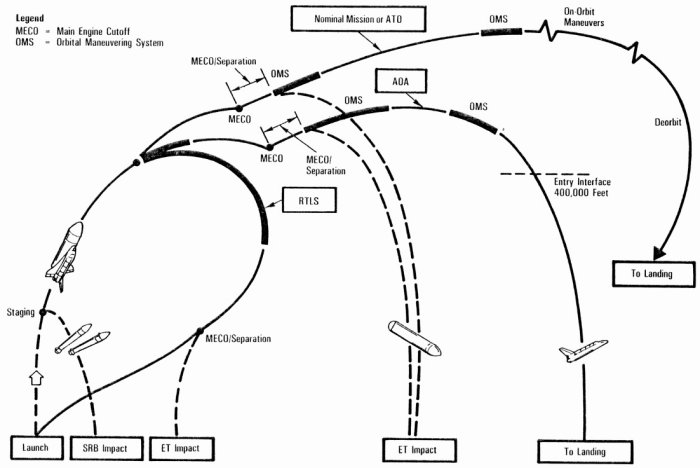
Four different intact abort modes are provided for including abort to orbit (ATO), abort once around (AOA), transatlantic landing (TAL), and return to launch site (RTLS). Contingency aborts include the east coast abort landing (ECAL) and bailout. The specific mode chosen depends on the type of failure and when it occurs. If vehicle performance is the only issue of concern, the abort modes in order of preference are ATO, AOA, TAL, and RTLS. The choice of abort type would be the highest on the list given the vehicle's remaining level of performance. If life support failures occur, time is more likely to be a critical factor and the most desirable abort mode would be the one that brings the crew back safely in the least amount of time. Contingency aborts are the least desirable because of their inherent risk and will never be selected if an intact abort option is available.
The Space Shuttle abort modes are explained in greater detail below. The contingency and intact abort options are listed in increasing order of preference.
Redundant Sequence Launch Sequencer (RSLS)
These pad aborts are controlled by computers that monitor the SSMEs to identify any potential problems. If a problem is detected prior to SRB ignition, the SSMEs are automatically shut down and the launch is aborted while the Shuttle is still on the pad. RSLS aborts have occurred five times between 1984 and 1994, all in the period between SSME start and SRB ignition. Once the solid rocket boosters have ignited, the Shuttle is committed to launch since the SRBs cannot be turned off. Any aborts after this time must be intact or contingency aborts.
Ditching
The most serious contingency aborts typically result from the loss of more than one main engine since the vehicle would not have enough thrust to accomplish one of the intact abort modes under these conditions. The Orbiter would most likely not be able to reach a landing site with so little thrust. If the Shuttle were to lose all three SSMEs during ascent, the Orbiter would almost certainly have ditch at sea. A crew bailout would be preferred, if possible, prior to ditching the Orbiter.
Under extreme conditions when the Orbiter cannot be landed and the crew is unable to bailout because of injury or insufficient time, the Orbiter could attempt a crash landing in water or on terrain other than a runway. Ditching at sea is the most likely scenario, although the odds of the crew surviving such a landing is considered very small.
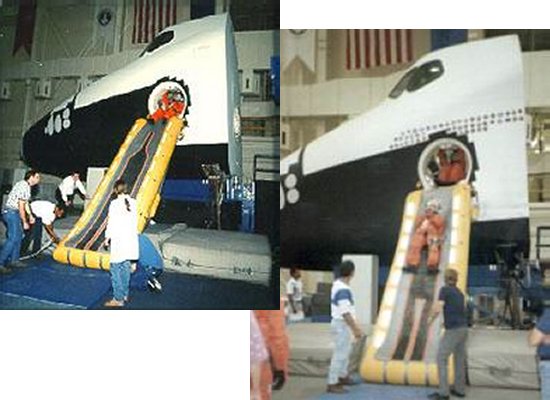
In any emergency landing scenario including those on a runway or a crash landing, the Orbiter is fitted with an emergency egress slide located at the main entry hatch. This slide, similar to those carried aboard commercial airliners, provides the crew a means of rapidly escaping from the Orbiter. Another emergency egress system for use if the slide is unavailable is the Sky Genie rope and pulley system. Sky Genie allows the crew to escape through hatches at the top of the crew cabin and rappel down the side of the Orbiter.

Bailout
This type of abort exists as a means of saving the crew if there is no hope of safely landing the Orbiter. This method is most likely to be implemented when the Orbiter is too far from a suitable landing site or is too seriously damaged to land safely. This abort option assumes the Orbiter has already been separated from its Solid Rocket Boosters (SRBs) and External Tank (ET) and is in controlled gliding flight. During a bailout, the pilot attempts to bring the Orbiter onto a level flight path at a relatively low altitude and speed. The Orbiter's flight controls also include an autopilot mode engaged by the pilot or commander that maintains an automatic stable flight while the crew escapes. Once safe flight conditions have been achieved, the crew opens the vehicle's main entry hatch to extend an escape pole through the hatch and out into the airstream. One after another, each crewmember attaches a hook assembly from the escape pole to his or her parachute harness and jumps out of the Orbiter through the hatch. The crewmember slides down the pole and off the end along a path that carries each person below the left wing of the Orbiter. Once safely away from the vehicle, each crewmember's parachute opens for a safe descent to the surface below.
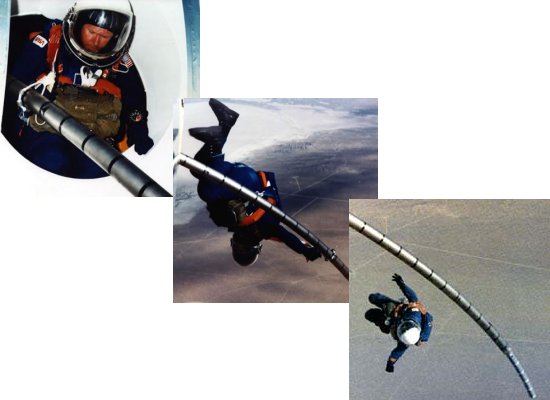
Once the crew had departed, the Orbiter will crash and is lost. A bailout is preferably done over water with the Orbiter pointed away from land as it comes down to minimize danger to lives and property. The crew should be able to survive long enough for search and rescue teams to recover them. Given the level of uncertainty involved in implementing the bailout scenario, it is considered a Contingency Abort method.
East Coast Abort Landing (ECAL)
Failure of multiple main engines does not always require bailing out and ditching the Orbiter depending on when the failure occurs during the launch profile. In addition, a contingency abort may be required when systems other than the engines fail. In either case, the Orbiter should be able to land intact for the safe recovery of the vehicle and crew.
The choice of landing site depends on the circumstances of the failure. A Return To Launch Site (RTLS) or Transatlantic Landing (TAL) is preferred but may not be possible due to the exact conditions of the flight problems. The RTLS option is also difficult to achieve when the Shuttle is launched into a high-inclination orbit to reach the International Space Station. The ECAL may be the only abort option available during such a launch until the vehicle travels far enough downrange for a TAL abort to be possible.
An ECAL abort is similar to the RTLS that will be discussed shortly except the Orbiter lands at the Kennedy Space Center during an RTLS scenario. In an ECAL, on the other hand, the Shuttle would attempt to land at another site along the east coast of North America. These emergency sites extend from South Carolina and Bermuda up into Newfoundland, Canada. The ECAL mode is a contingency abort that is less desirable that an intact abort primarily because there is so little time to choose the landing site and prepare for the Orbiter's arrival. The ECAL emergency sites are not as well equipped to accommodate an Orbiter landing.
Return To Launch Site (RTLS)
The RTLS mode is an intact abort scenario that allows the Orbiter to turn around while under power and return directly to land at or near the launch site at Kennedy Space Center, Florida (KSC). The Orbiter would land approximately 25 minutes after lift-off with the safe recovery of the crew and payload. The RTLS mode is most likely to be implemented following the loss of thrust from one main engine between lift-off and four minutes 20 seconds into flight. Beyond this time, the Shuttle has too little fuel left to turn around and reach KSC.
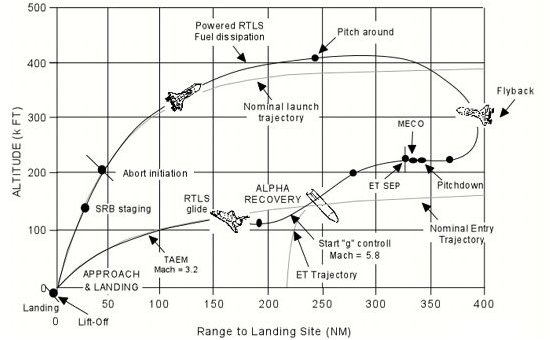
The RTLS abort begins with a powered stage when the Orbiter's SSMEs are still generating thrust. The profile can only begin after the SRBs have been jettisoned and the crew positions the abort rotary switch to RTLS and depresses the abort push button. The time when the abort option is selected depends on the nature of the engine failure. If an engine fails at launch, for example, the abort will begin as soon as the SRBs separate at two minutes 20 seconds. Once selected, the Shuttle continues flying along its downrange flight path to use up excess propellant and leave only enough fuel to turn the vehicle around and reach Florida. The vehicle also performs a pitch maneuver during this stage so that it flips over to point its nose back at the launch site with the Orbiter on top in a heads-up configuration. Even though pointed back towards KSC, the Shuttle's momentum is still carrying it away from the launch site. However, the new orientation of the vehicle's thrust gradually negates its downrange velocity.
As the Shuttle burns its remaining fuel, it also fires the OMS engines and Reaction Control System (RCS) thrusters or dumps the propellants to reduce weight. With the powered phase of the RTLS abort coming to an end, the vehicle pitches down to achieve conditions necessary for jettison of the External Tank. ET separation includes use of the RCS thrusters to move the Orbiter away from the tank and ensure the two objects do not re-contact. Following ET separation, the Orbiter begins an unpowered glide stage as the vehicle approaches the landing site. The glide and landing are very similar to a normal Orbiter recovery.
Transatlantic Landing (or Transoceanic Landing) (TAL)
The next intact abort option is the TAL mode that allows the Orbiter to land safely on the eastern side of the Atlantic Ocean following a ballistic trajectory. A TAL abort is intended for use during the time after RTLS is no longer available and before an AOA abort can be achieved using just two SSMEs. The TAL may also be implemented if a major failure in life-support systems makes landing as soon as possible a necessity.
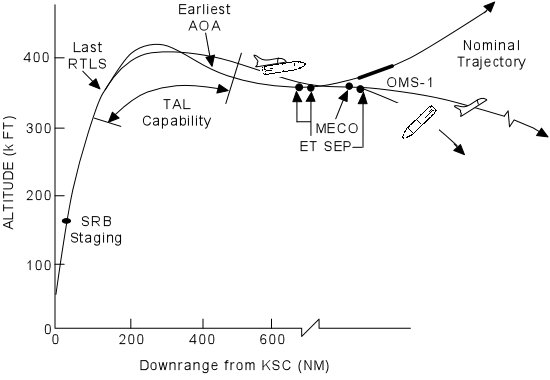
The TAL abort calls for the Shuttle to remain on its normal flight path past SRB separation but deviate away from an orbital trajectory before Main Engine Cut-Off (MECO). To engage the scenario, crew must rotate the abort rotary switch to the TAL/AOA position and depress the abort push button prior to MECO. The vehicle automatically steers towards the landing sites on the other site of the Atlantic and rolls into a heads-up configuration while the main engines are still firing. The OMS and RCS systems are not required for TAL, so their propellants are automatically dumped to lighten the Orbiter and move its center of gravity to an acceptable location for gliding flight.
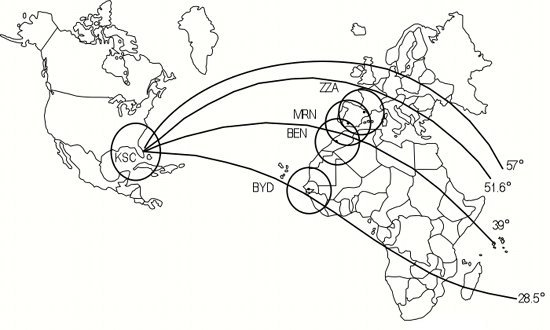
After MECO and ET separation, the Orbiter continues along its ballistic flight path to make a landing about 45 minutes after lift-off. Two TAL landing sites are selected and staffed with personnel prior to launch. Those selected for a given mission are preferably closest to the Shuttle's ascent ground track during that flight to make the best use of the Shuttle's fuel. The site must also have a runway of sufficient length, acceptable weather conditions, and approval from the US State Department. Two sites are in Spain located at Morón at the southern tip of the country and Zaragoza in the northeast. Other sites include Istres in France and Banjul in The Gambia. This list of sites changes over time depending on foreign relations and the state of the landing sites. Ben Guerir, Morocco was used for many years but has been eliminated because of terrorism fears. Other TAL sites used in the past have included Kano, Nigeria; Rota, Spain; Casablanca, Morocco; and Dakar, Senegal.
Abort Once Around (AOA)
During an AOA abort, the vehicle does enter orbit but one that is too low to maintain. The Orbiter instead makes a normal entry and landing after circling the planet just one time. This type of abort is most likely to be used following a propulsion failure that leaves too little thrust to achieve the desired orbit. Another scenario under which AOA could be implemented is if the Orbital Maneuvering System runs low on propellant before reaching the desired orbit and there is only enough left to accomplish a de-orbit burn for return to Earth. These possibilities are referred to as performance aborts. An AOA might also be used in case of a systems abort during which the failure of one or more key Orbiter systems requires a quick return to Earth. The AOA mode is selected once the crew rotates the abort rotary switch to the TAL/AOA position and depresses the abort push button after the vehicle passes the Main Engine Cut-Off point.
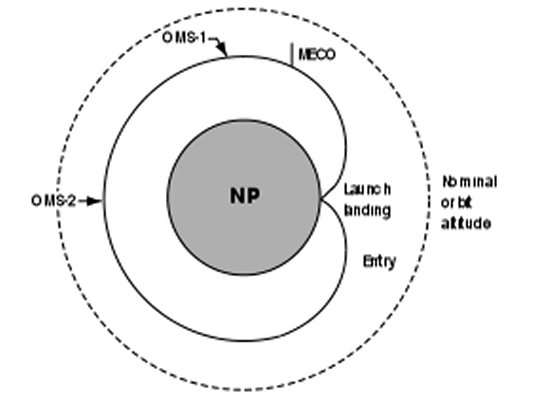
Once activated, the normal OMS thrusting profile is modified to two sequences. The first OMS burn changes the Orbiter's trajectory during its post-MECO transfer orbit such that a second burn causes the vehicle to leave orbit and reenter the atmosphere. The Orbiter then follows a normal reentry trajectory to touch down at one of the planned landing sites about 90 to 110 minutes after lift-off. Locations used for an AOA abort include the primary landing sites at Kennedy Space Center, Florida, and Edwards Air Force Base, California, as well as the backup site at White Sands, New Mexico.
Abort To Orbit (ATO)
An ATO abort is almost the same as a normal launch except the vehicle reaches an orbit lower than originally planned. This scenario is only possible due to a loss of engine performance during launch that results in insufficient thrust to achieve the desired orbit. However, the vehicle is still able to reach an adequate circular orbit at a lower altitude. Unlike an AOA orbit that is too low to maintain, the ATO orbit is safe and stable and can be maintained for a long period of time. This orbit gives the crew and mission controllers time to evaluate problems and determine future actions to be taken. They may opt to de-orbit and return to Earth early or use the OMS to raise the orbit to higher altitude and continue the mission as planned. The mission could be as short as three orbits or as long as its planned duration depending on the amount of propellant available and the nature of problems with the vehicle.
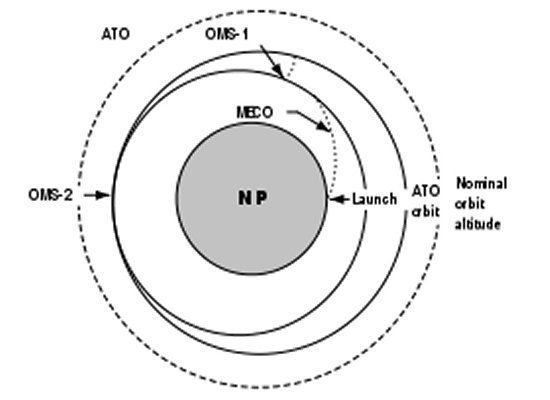
An ATO abort is the only kind that has ever been used when it was required during a Challenger launch on 29 July 1985. Five minutes and 45 seconds into flight, a sensor problem caused center engine #1 to shutdown prematurely. Because of the loss of thrust, Challenger was unable to achieve its 190 nm orbit and was instead placed in a 140 nm orbit as part of the ATO scenario. The change had little impact on the mission and Challenger met its objectives successfully.
Abort Decision
Though the crew has access to some information about the status of the Shuttle during ascent, the Mission Control Center (MCC) in Houston, Texas, has the greatest knowledge of how well vehicle systems are performing. This information gives MCC primary authority for determining if and when one of the abort modes will be implemented. During launch, mission controllers can be heard periodically calling out which abort options are available at that time or when the vehicle passes points at which a given abort mode can no longer be used. Should communications with MCC be lost, information is also available to the crew on cockpit displays allowing them to know what the preferred abort option is at that stage of flight.
If conditions during launch deteriorate to the point that an abort is warranted, MCC and/or the astronauts select which option to use depending on several factors. These factors include the specific failure, the time when it occurs, and which abort mode is the safest to implement or most improves the likelihood of a successful mission. In case of a main engine failure, MCC and the flight crew select the best abort option available at the point in flight when that failure occurred. Failure of a system like life support that threatens the safety of the crew, on the other hand, warrants selecting an abort option that returns the Orbiter to Earth as quickly as possible. The RTLS and TAL options take the least amount of time, but the specific abort chosen also depends on when the system failure occurs.
Landing Sites
The list of acceptable landing sites for the Space Shuttle Orbiter changes regularly depending on relations between the United States and foreign nations, the condition of runways of suitable length, and the availability of navigational aids that assist in making a safe landing. As such, it is difficult to provide an up-to-date list of sites since locations are added or removed as circumstances dictate. In general, Orbiter landing sites can be divided into five categories. The following list describes each type of landing site and the locations meeting those criteria. Those marked by italics are shown on some sources but not others and may no longer be used.
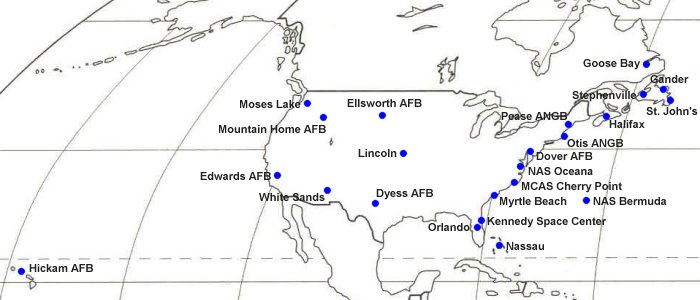
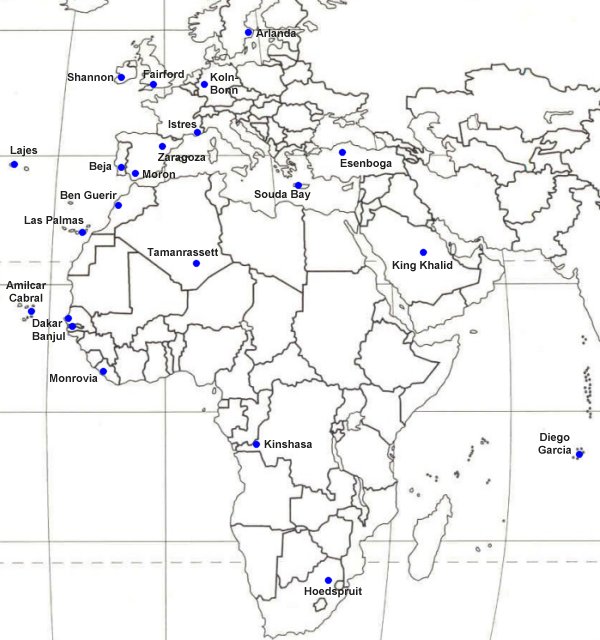
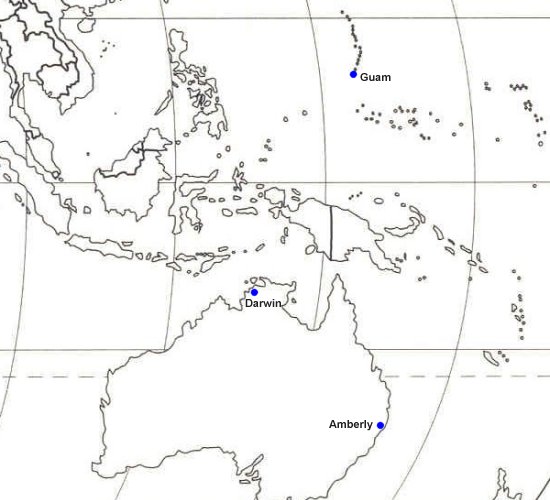
Summary
The majority of the Space Shuttle abort modes were developed before the vehicle ever flew to provide some means of saving the Orbiter and crew under various failure mechanisms. Designers felt that a performance abort due to a main engine failure was the most likely situation, but the loss of the Challenger in 1986 prompted a reevaluation of the abort options. That disaster led to the development of the contingency abort options including the East Coast Abort Landing and improved emergency egress systems. Among these was the installation of the escape pole and development of the bailout procedure.
Though none of these contingency aborts has ever been used, the Columbia Accident Investigation Board (CAIB) felt
that a bailout could have possibly saved the crew during that tragic accident. The CAIB believed the crew had
sufficient resources available to conduct a partial repair of impact
damage to the Orbiter's leading edge that would have allowed the vehicle to survive reentry long enough to
bring the craft into a low-speed level flight path. Though the Orbiter would have likely suffered damage too
severe to land, the crew could have been able to bailout under this scenario. The attempt would have been a very
risky one but would have at least given the seven crewmembers a chance of survival.
- answer by Justine Whitman, 25 June 2006
Related Topics:
Read More Articles:


|
Aircraft | Design | Ask Us | Shop | Search |

|
|
| About Us | Contact Us | Copyright © 1997-2023 | |||
|
|
|||